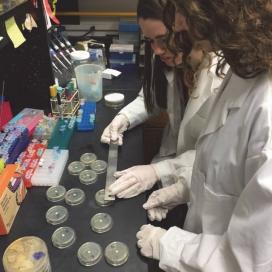ERC Sparks Undergraduate Creativity by Moving Real-World Content to Core-Science Laboratories
Research teams at the Center for Biorenewable Chemicals (CBiRC), an NSF-funded Engineering Research Center (ERC) headquartered at Iowa State University (ISU), have updated core-science laboratories with real-world, sustainability-relevant content. To that end, the researchers discovered a convenient three-component condensations reaction process and, with the help of colleagues from the chemistry and microbiology departments, created a module for use in undergraduate chemistry and microbiology education.
This action fosters more creative and innovative students. The project took the CBiRC-derived triacetic acid lactone (TAL) reaction pathway to a classroom-laboratory setting in a way that allows hundreds of students per year to work on it. Specifically, each student combined three components to make a product that only they had made. Because each student isolated a unique product, the class made a series of compounds with the same general structure, but with some varied substitution (i.e., on the amine and the aryl ring). In addition, rather than ending with this synthesis activity, CBiRC’s interest in potential commercial viability led the faculty to team with the instructors of a large undergraduate microbiology class. As a result, the compounds developed by the chemistry class were tested for antibacterial activity by undergraduate microbiology majors, and a few compounds exhibited moderate antibacterial activity.
Some types of three-component reactions are especially desirable to organic chemists because they allow for the rapid evolution of molecular diversity, which in turn has implications for the potential economic benefits of a CBiRC approach to making diverse chemicals. Building on this knowledge, CBiRC researchers found a type that could be accomplished inexpensively at ambient temperatures; the reaction conditions were so efficient that crystalline products were produced in minutes. Realizing that these characteristics could be useful for undergraduate education and discussing the possibility with chemistry and microbiology department colleagues, they designed an experiment for the non-majors’ undergraduate chemistry laboratory and the undergraduate microbiology laboratory.
The library of compounds produced in the chemistry laboratory was tested by students in the microbiology laboratory. The first test of this approach in the Fall 2015 semester was successful. This experiment was continued in the Spring 2016 semester, where over 400 students experienced the excitement of cutting-edge research (see figure).


